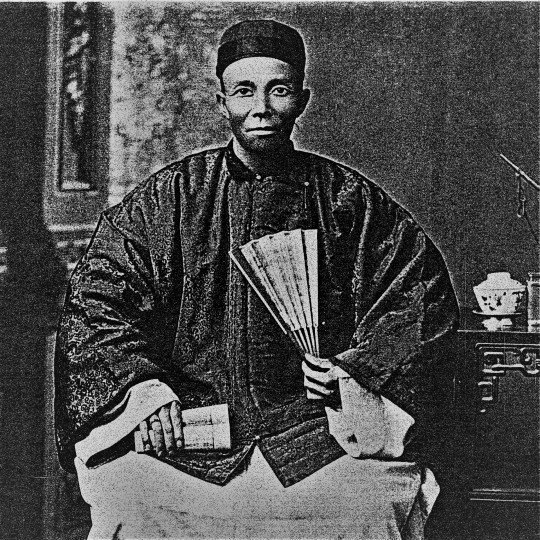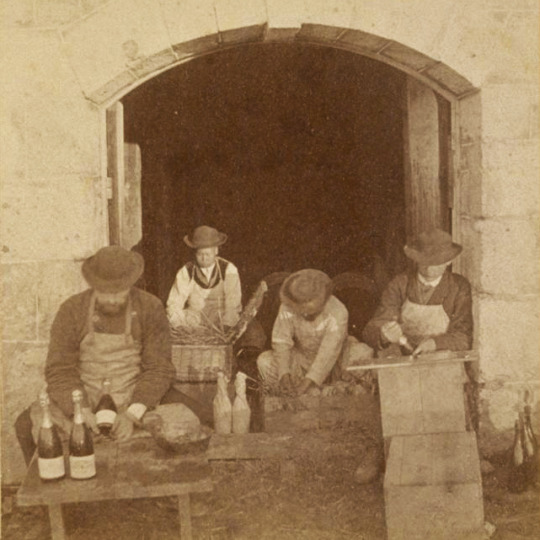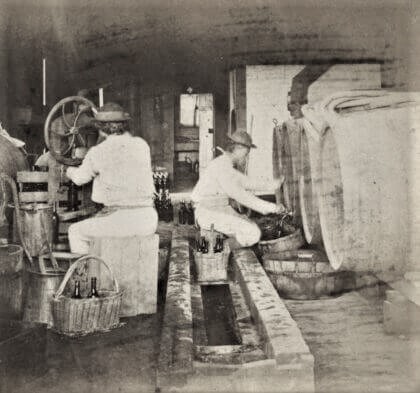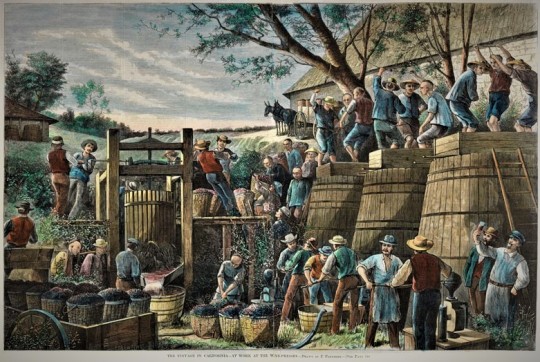#Chinese labor at Buena Vista winery
Explore tagged Tumblr posts
Photo

Vineyard workers. Watercolor by Jake Lee (from the collection of the Chinese Historical Society of America).
Chinese Pioneers in California’s Wine Industry
The work by the Chinese is excavating the wine caves for what would become the Buena Vista winery has been well known and researched by the original deans of Chinese American historiography, the late Phil Choy and Him Mark Lai. The story of Chinese participation in building this industry of Sonoma County and California continues to attract the interest of local historians.
In 2018, I toured the BV winery again last year with the executive director of the Chinese Historical Society of America. With a couple exceptions, most of the guides were aware of the provenance of BV’s wine caves. The then-new ownership appears more committed to recounting the substantial contributions made by Chinese labor and engineering staff into the larger history of this landmark winery. Photos of Chinese men working in the fields and bottling wine are displayed in Buena Vista’s tasting room.
“We feel it’s more important than ever to talk about the reason we exist and the people who contributed to it − Chinese, Hungarian, French,” says Jean-Charles Boisset, whose family company, Boisset Collection, a US subsidiary of Boisset, La Famille des Grands Vins (France’s third largest wine holding company and Burgundy’s largest producer), bought BV in 2011.
An 2017 article by NPR food reporter, Grace Hwang Lynch, summarized the labor and the ultimate fate of the Chinese workers whose involvement in virtually all phases of the production literally built a multi-billion dollar industry for Northern California and the US. “In 1857,” Hwang wrote, “a wealthy Hungarian named Agoston Haraszthy purchased a ranch in Sonoma Valley and named it Buena Vista, with the vision of introducing winemaking techniques from his homeland. . . . Haraszthy turned to Ho Po, a Chinese labor contractor from San Francisco, who sent 150 of his countrymen to build Buena Vista, Sonoma's oldest commercial winery.“

Ho Po, a Chinese labor contractor from San Francisco, sent 150 of his countrymen to build Buena Vista. Photographer unknown (courtesy of Buena Vista winery).
The Chinese workers dug a cave network for the BV winery which is actually more extensive than what a causal tour will disclose. However, a couple of the 19th century excavations have collapsed due to past seismic activity.
Chinese labor also dug the caves for other wineries. In 1870, Jacob Schram found new employment for the Chinese laborers who had recently finished constructing tunnels and grades over the Sierra Nevada Mountains for the Union Pacific Transcontinental Railroad.Schram hired them to dig a network of caves through the soft Sonoma Volcanics Formation rock underlying his vineyard. To its credit, the Schramsberg website also acknowledges the Chinese laborers who dug Napa’s first hillside caves for wine-aging and storage.

Chinese and other men bottle sparkling and other wine products at the Buena Vista winery, c. 1880. Photograph by Eadweard Muybridge(from the collection of the Buena Vista winery).

Chinese workers transport wine in front of the main building (which still stands today) at Buena Vista, the oldest winery in California's Sonoma County. Photographer unknown (from the collection of the Buena Vista winery)
In the late 1870′s Hwang recounts, the locals began to drive out the Chinese from Sonoma County’s vineyards through economic boycott or worse.

“1106 -- Buena Vista Vineyard, Sonoma -- Bottling Wine,” no date. Photographer unknown (from the collection of Buena Vista Winery and George Webber).
The experience of the Sonoma County Chinese demonstrates that the aggregate, private violence continued even after the passage of the Chinese Exclusion Act of 1882. Local law enforcement either turned a blind eye or aided such violence, and the decades that straddled 1882 produced an internal migration of nonwhite Americans in the western US that had not been seen since the Trail of Tears (which was essentially done at gunpoint in a military operation), and would not be seen again until the Great Migration of African-Americans from the rural South between 1916 and 1970.
The Chinese would remain in vintners’ workforces into the next century, local conditions permitting. However, the Chinese Exclusion Act of 1882 would continue to exact a toll on the population of laborers, and growers would gravitate toward other groups of agricultural workers.

“Chinese farm workers pruning a vineyard,” c. 1900. Photographer unknown (from the Title Insurance and Trust Collection of the California Historical Society). CHS wrote about this photo in its Spring 1978 quarterly as follows: “Under the watchful eyes of Yankee overseers, Chinese laborers built California’s railroad, reclaimed the Delta, and nursed the state’s infant agriculture, including its vineyards. .
The Chinese pioneers left as their legacy the foundation of a multi-billion dollar industry upon which the economy of California prospers in the 21st century. Even today, researchers and writers continue to coax from the historical record more stories of a vibrant presence in the state’s earliest vineyards.

“The Vintage In California -- At Work At the Wine Presses.” Drawing by Paul Frenzeny (from the Robert B. Honeyman, Jr. Collection of Early Californian and Western American Pictorial Material at the Bancroft Library)
Note about the artist (by Theresa Salazar of the Bancroft Library):
French artist Paul Frenzeny came to North America in the 1860s to serve under Marshal Achille Bazaine, commander of the French expeditionary corps in Mexico, sent to support Napoleon Ill's abortive effort to establish an empire there under Archduke Maximilian of Austria. Sometime before 1868 Frenzeny went to New York City, for between that year and 1873 Harpers Weekly published some twenty of his sketches, showing New York views as well as events in the Mexican war and the Pennsylvania coal fields (Samuels, p. 178).
Harpers commissioned Frenzeny and Jules Tavernier, another Frenchman, to travel across the country and record the landscape in remote, unexplored areas, telling its readers that "these gentle-men will not restrict themselves to the ordinary routes of travel. They will make long excursions on horseback into regions where railroads have not penetrated, where even the hardy squatter, the pioneer of civilization, has not yet erected his rude log-cabin" (Harpers Weekly, November 8, 1873, p. 994). The men left New York in the fall of 1873 and reached San Francisco the following summer, riding horseback from Denver.
Frenzeny apparently stayed on in San Francisco for at least six years and became known for his illustrations and sketches of Chinatown (Hughes, p. 400). He participated in the artistic life of the city and became a member of the new Bohemian Club. His partnership with Tavernier may have ended shortly after the men arrived in San Francisco, for Harper's illustrations of California and Nevada subjects between 1876 and 1878 and in the early eighties were signed by Frenzeny alone. In 1879 Harper's published Central American drawings executed on his journey back to New York. Between 1882 and 1887 Frenzeny's work appeared in Leslie's Weekly. Frenzeny later provided 150 illustrations for Harrington O'Reilly's Fifty Years on the Trail, Frenzeny’s last known publication (1889). The last decade or so of his life is undocumented, but he is believed to have died in London in 1902 (Karolik, 1:163-164; and Hughes, p. 192).
#Chinese winery workers#Chinese labor at Buena Vista winery#Chinese workers for Schram#Chinese in Sonoma County#wine cave excavation#Eadweard Muybridge#Paul Frenzeny
1 note
·
View note
Photo


From NPR website:
Chinese workers transport wine at Buena Vista, the oldest winery in California's Sonoma County, built in the mid-1800s. From the backbreaking labor of clearing roads and digging out caves to highly skilled horticultural work, Chinese laborers helped build Sonoma's wine country.
In 1857, a wealthy Hungarian named Agoston Haraszthy purchased a ranch in Sonoma Valley and named it Buena Vista, with the vision of introducing winemaking techniques from his homeland. He turned to Ho Po, a Chinese labor contractor from San Francisco, who sent 150 of his countrymen to build Buena Vista. Between 1856 and 1869, Chinese planted the majority of Sonoma County's 3.2 million grapevines. However, as the vineyards grew, so did backlash against the Chinese on the West Coast. Anti-Chinese leagues were formed in many counties, with whites accusing Chinese of undercutting wages. Congress eventually passed the Chinese Exclusion Act in 1882, barring nearly all immigration from China. And whites drove out Chinese from many rural areas throughout the West. During that period, a lot of Chinese left Sonoma. According to U.S. Census data, the Chinese population in Sonoma County dropped from 1,145 in 1890 to fewer than 200 in 1930.
Source: NPR
#Chinese Americans#labourers#vineyard#wine#Buena Vista Winery#Sonoma County#California#Agoston Haraszthy#winemaking#Ho Po#1850s#1860s#racism#Chinese Exclusion Act
14 notes
·
View notes
Text
Chinese Laborers Built Sonoma's Wineries. Racist Neighbors Drove Them Out : The Salt : NPR Headlines News
Chinese Laborers Built Sonoma’s Wineries. Racist Neighbors Drove Them Out : The Salt : NPR Headlines News
Chinese Laborers Built Sonoma’s Wineries. Racist Neighbors Drove Them Out : The Salt : NPR Headlines News

Chinese workers transport wine at Buena Vista, the oldest winery in California’s Sonoma County, built in the mid-1800s. From the backbreaking labor of clearing roads and digging out caves to highly skilled horticultural work, Chinese laborers helped build Sonoma’s wine country.
View On WordPress
0 notes
Text
Chinese Laborers Built Sonoma's Wineries. Racist Neighbors Drove Them Out
Enjoying a chardonnay or cabernet sauvignon? In the 1800s, Chinese immigrants helped introduce those iconic varietals to California's wine country. But as vineyards grew, so did anti-Chinese fervor.
(Image credit: Courtesy of Buena Vista winery)
0 notes
Text
Chinese Laborers Built Sonoma's Wineries. Racist Neighbors Drove Them Out
Enjoying a chardonnay or cabernet sauvignon? In the 1800s, Chinese immigrants helped introduce those iconic varietals to California's wine country. But as vineyards grew, so did anti-Chinese fervor.
(Image credit: Courtesy of Buena Vista winery)
0 notes